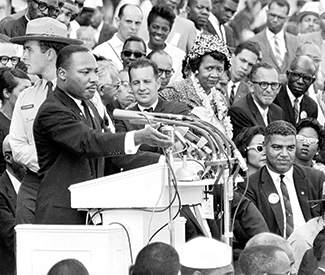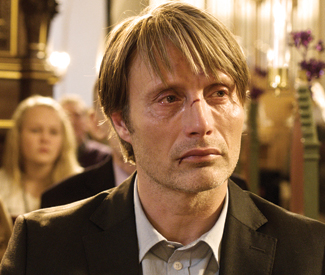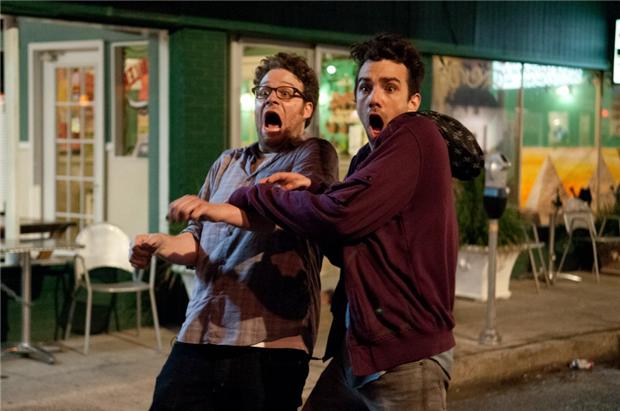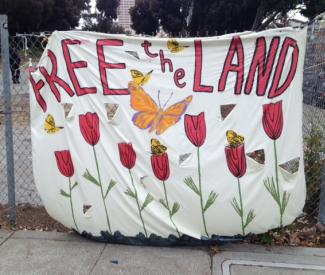WEDNESDAY 28
ROCK
Bottom of the Hill: 1233 17th St., San Francisco. Whirr, Nothing, Lycus, 9 p.m., $10.
Cafe Du Nord: 2170 Market, San Francisco. Everest, White Dove, The Iron Heart, Aaron Lee Tasjan, 8 p.m., $10-$12.
El Rio: 3158 Mission, San Francisco. Beast Fiend, Raised by Zebras, The Lucky Eejits, 8 p.m., $5.
Hemlock Tavern: 1131 Polk, San Francisco. Fronds, Is/Is, Locomotives, 8:30 p.m., $7.
Hotel Utah: 500 Fourth St., San Francisco. Girls & Boys, Sad Robot, Saffell, 8 p.m., $8.
The Independent: 628 Divisadero, San Francisco. Spin Doctors, Solwave, 8 p.m., $15.
The Knockout: 3223 Mission, San Francisco. The Connies, Bicycle Day, Ex’s with Benefits, 9:30 p.m., $6.
Milk Bar: 1840 Haight, San Francisco. Ghost Parade, Belle Noire, A Midnight Drive, 8:30 p.m., $8.
Neck of the Woods: 406 Clement St., San Francisco. Modern Pantheist, The Spiral Electric, Mamri, 9 p.m., $5.
Sub-Mission Art Space (Balazo 18 Gallery): 2183 Mission, San Francisco. Moral Crux, The Nerv, The Rind, 9 p.m., $8.
Thee Parkside: 1600 17th St., San Francisco. Banner Pilot, Civil War Rust, The Breaks, 9 p.m., $10.
DANCE
Brick & Mortar Music Hall: 1710 Mission, San Francisco. Vinyl Only Dance Party, w/ DJs Jackie Sugarlumps, Joel Gion, Al Lover, Mario Delia, and more, 8 p.m., $3.
The Cafe: 2369 Market, San Francisco. “Sticky Wednesdays,” w/ DJ Mark Andrus, 8 p.m., free.
Cat Club: 1190 Folsom, San Francisco. “Bondage A Go Go,” w/ DJs Damon, Tomas Diablo, & guests, 9:30 p.m., $5-$10.
The Cellar: 685 Sutter, San Francisco. “Eye Candy Wednesdays,” 9 p.m., free.
Club X: 715 Harrison, San Francisco. “Electro Pop Rocks,” 18+ dance party, 9 p.m., $10-$20.
Edinburgh Castle: 950 Geary, San Francisco. “1964,” w/ DJ Matt B & guests, Second and Fourth Wednesday of every month, 10 p.m., $2.
Elbo Room: 647 Valencia, San Francisco. “Bodyshock,” w/ DJs Blk Rainbow, Crackwhore, and Unit 77, 9:30 p.m., $5.
F8: 1192 Folsom St., San Francisco. “Housepitality,” w/ Sweet P, Tasho, Deron, Jonene, Victor Vega, Mr. Bean, 9 p.m., $5-$10.
Harlot: 46 Minna, San Francisco. “Qoöl,” w/ Spesh, 5 p.m.
Infusion Lounge: 124 Ellis, San Francisco. “Indulgence,” 10 p.m.
Lookout: 3600 16th St., San Francisco. “What?,” w/ resident DJ Tisdale and guests, 7 p.m.
Madrone Art Bar: 500 Divisadero, San Francisco. “Rock the Spot,” 9 p.m., free.
MatrixFillmore: 3138 Fillmore, San Francisco. “Innov8,” 8 p.m.
Monarch: 101 6th St., San Francisco. “Queen Bitch,” w/ DJs Major Sean, Valentino, Cookie Sioux, and Baron Van West, 9 p.m., free.
Q Bar: 456 Castro, San Francisco. “Booty Call,” w/ Juanita More, Joshua J, guests, 9 p.m., $3.
HIP-HOP
Double Dutch: 3192 16th St., San Francisco. “Cash IV Gold,” w/ DJs Kool Karlo, Roost Uno, and Sean G, 10 p.m., free.
Skylark Bar: 3089 16th St., San Francisco. “Mixtape Wednesday,” w/ resident DJs Strategy, Junot, Herb Digs, & guests, 9 p.m., $5.
ACOUSTIC
Bazaar Cafe: 5927 California, San Francisco. Acoustic Guitar Showcase, hosted by Teja Gerken, 7 p.m.
Cafe Divine: 1600 Stockton, San Francisco. Craig Ventresco & Meredith Axelrod, 7 p.m., free.
Fiddler’s Green: 1333 Columbus, San Francisco. Terry Savastano, Every other Wednesday, 9:30 p.m., free/donation.
Plough & Stars: 116 Clement, San Francisco. The Toast Inspectors, Last Wednesday of every month, 9 p.m.
Yoshi’s San Francisco: 1330 Fillmore, San Francisco. Casey Abrams, 8 p.m., $22.
JAZZ
Amnesia: 853 Valencia, San Francisco. Gaucho, Eric Garland’s Jazz Session, The Amnesiacs, 7 p.m., free.
Boom Boom Room: 1601 Fillmore, San Francisco. Bjelde & Bros., Fourth Wednesday of every month, 9:30 p.m., $5.
Burritt Room: 417 Stockton St., San Francisco. Terry Disley’s Rocking Jazz Trio, 6 p.m., free.
Club Deluxe: 1511 Haight, San Francisco. The Techtonics, Every other Wednesday, 8:30 p.m., free.
Jazz Bistro At Les Joulins: 44 Ellis, San Francisco. Charles Unger Experience, 7:30 p.m., free.
Le Colonial: 20 Cosmo, San Francisco. The Cosmo Alleycats featuring Ms. Emily Wade Adams, 7 p.m., free.
Martuni’s: 4 Valencia, San Francisco. Tom Shaw Trio, Last Wednesday of every month, 7 p.m., $7.
Oz Lounge: 260 Kearny, San Francisco. Hard Bop Collective, 6 p.m., free.
Pier 23 Cafe: Pier 23, San Francisco. Macy Blackman, 6 p.m., free.
Revolution Cafe: 3248 22nd St., San Francisco. Michael Parsons Trio, Every other Wednesday, 8:30 p.m., free/donation.
Savanna Jazz Club: 2937 Mission, San Francisco. “Cat’s Corner,” 9 p.m., $10.
Sheba Piano Lounge: 1419 Fillmore, San Francisco. City Jazz Instrumental Jam Session, 8 p.m.
Top of the Mark: One Nob Hill, 999 California, San Francisco. Ricardo Scales, Wednesdays, 6:30-11:30 p.m., $5.
Zingari: 501 Post, San Francisco. Chris Duggan, 7:30 p.m., free.
INTERNATIONAL
BeatBox: 314 11th St., San Francisco. “Salsa-XS,” queer salsa night, 8 p.m.
Bissap Baobab: 3372 19th St., San Francisco. Timba Dance Party, w/ DJ WaltDigz, 10 p.m., $5.
Cafe Cocomo: 650 Indiana, San Francisco. “Bachatalicious,” w/ DJs Good Sho & Rodney, 7 p.m., $5-$10.
Cigar Bar & Grill: 850 Montgomery, San Francisco. Grupo da Sete, 8 p.m.
Pachamama Restaurant: 1630 Powell, San Francisco. “Cafe LatinoAmericano,” 8 p.m., $5.
Union Square Park: 333 Post, San Francisco. Oscar Reynolds, 12:30 p.m., free.
BLUES
Biscuits and Blues: 401 Mason, San Francisco. Ray Bonneville, 8 & 10 p.m., $15.
The Royal Cuckoo: 3202 Mission, San Francisco. Big Bones & Chris Siebert, 7:30 p.m., free.
The Saloon: 1232 Grant, San Francisco. G.G. Amos, 9:30 p.m., free.
EXPERIMENTAL
Meridian Gallery: 535 Powell, San Francisco. Shelley Hirsch, 8 p.m., $8-$10.
SOUL
The Cellar: 685 Sutter, San Francisco. “Color Me Badd,” w/ DJ Matt Haze, Wednesdays, 5-9 p.m.
THURSDAY 29
ROCK
Boom Boom Room: 1601 Fillmore, San Francisco. Nikki Hill, 9:30 p.m., $10-$12.
Bottom of the Hill: 1233 17th St., San Francisco. FIDLAR, Meat Market, 9 p.m., $12-$14.
The Chapel: 777 Valencia St., San Francisco. Converse Rubber Tracks Live: Kylesa, Torche, 8 p.m., free.
S.F. Eagle: 398 12th St., San Francisco. Thursday Nite Live: Bronze, Apache, Dancer, 9 p.m., $7.
Hemlock Tavern: 1131 Polk, San Francisco. Talkative, Mufassa, Luke Sweeney & Wet Dreams Dry Magic, 8:30 p.m., $6.
Monarch: 101 6th St., San Francisco. Mission Bells, Devon McClive & Sons, Exhausted Pipes, Lily Taylor, 8 p.m., $8.
Thee Parkside: 1600 17th St., San Francisco. Dead to Me, The Riverboat Gamblers, Blacklist Royals, The Radishes, 9 p.m., $12.
DANCE
Abbey Tavern: 4100 Geary, San Francisco. DJ Schrobi-Girl, 10 p.m., free.
Audio Discotech: 316 11th St., San Francisco. “Phonic,” w/ Hook N Sling, St. John, 9:30 p.m.
Aunt Charlie’s Lounge: 133 Turk, San Francisco. “Tubesteak Connection,” w/ DJ Bus Station John, 9 p.m., $5-$7.
BeatBox: 314 11th St., San Francisco. “Jukebox,” w/ DJ Page Hodel, 9 p.m., $10.
The Cafe: 2369 Market, San Francisco. “¡Pan Dulce!,” 9 p.m., $5.
Cat Club: 1190 Folsom, San Francisco. “Throwback Thursdays,” ‘80s night with DJs Damon, Steve Washington, Dangerous Dan, and guests, 9 p.m., $6 (free before 9:30 p.m.).
The Cellar: 685 Sutter, San Francisco. “XO,” w/ DJs Astro & Rose, 10 p.m., $5.
Club X: 715 Harrison, San Francisco. “The Crib,” 9:30 p.m., $10, 18+.
Elbo Room: 647 Valencia, San Francisco. “Afrolicious,” w/ DJs Pleasuremaker, Señor Oz, and live guests, 9:30 p.m., $5-$8.
The EndUp: 401 Sixth St., San Francisco. EDMSF Thursdays, 10 p.m., $10 (free before midnight).
Infusion Lounge: 124 Ellis, San Francisco. “I Love Thursdays,” 10 p.m., $10.
The Knockout: 3223 Mission, San Francisco. N.O.W., Airport, Bankie Phones, Deastro, plus DJs Mashi Mashi, Smac, and Shannon, 9:30 p.m., $7.
Madrone Art Bar: 500 Divisadero, San Francisco. “Night Fever,” 9 p.m., $5 after 10 p.m.
Make-Out Room: 3225 22nd St., San Francisco. “Frisco Disco,” w/ DJs 2shy-shy & Melt w/U, 8 p.m., free.
MatrixFillmore: 3138 Fillmore, San Francisco. “Fusion,” w/ DJ Big Bad Bruce, 9 p.m., $5.
Q Bar: 456 Castro, San Francisco. “Throwback Thursday,” w/ DJ Jay-R, 9 p.m., free.
Raven: 1151 Folsom St., San Francisco. “1999,” w/ VJ Mark Andrus, 8 p.m., free.
Rickshaw Stop: 155 Fell, San Francisco. “Popscene: 17-Year Anniversary Party,” featuring a “very special band” to be announced August 25, 10 p.m.
Ruby Skye: 420 Mason, San Francisco. “Awakening,” w/ Quintino, 9 p.m., $15-$20 advance.
The Tunnel Top: 601 Bush, San Francisco. “Tunneltop,” DJs Avalon and Derek ease you into the weekend with a cool and relaxed selection of tunes spun on vinyl, 10 p.m., free.
Underground SF: 424 Haight, San Francisco. “Bubble,” 10 p.m., free.
Vessel: 85 Campton, San Francisco. “Base: Attack of the DJs – The Make It Funky All-Star Edition,” w/ Lisa Rose, OneMoHit, Fortune Cookie, Jay Handles, 404, 10 p.m., $5-$10.
HIP-HOP
Eastside West: 3154 Fillmore, San Francisco. “Throwback Thursdays,” w/ DJ Madison, 9 p.m., free.
John Colins: 138 Minna, San Francisco. “Hella ‘90s,” w/ DJs Apollo & IllEfect, 9 p.m., free before 11:30 p.m.
Park 77 Sports Bar: 77 Cambon, San Francisco. “Slap N Tite,” w/ resident Cali King Crab DJs Sabotage Beats & Jason Awesome, free.
The Parlor: 2801 Leavenworth, San Francisco. “Locals Night Out,” w/ DJ Illy D, 9 p.m., free.
Skylark Bar: 3089 16th St., San Francisco. “Peaches,” w/lady DJs DeeAndroid, Lady Fingaz, That Girl, Umami, Inkfat, and Andre, 10 p.m., free.
ACOUSTIC
Atlas Cafe: 3049 20th St., San Francisco. Bluegrass & Old-Time Music Jam Session, Last Thursday of every month, 8-10 p.m., free.
Cafe Du Nord: 2170 Market, San Francisco. Scout Niblett, P.G. Six, Michael Beach, 8 p.m., $10-$12.
Plough & Stars: 116 Clement, San Francisco. Crooked Road, 9 p.m.
The Rite Spot Cafe: 2099 Folsom, San Francisco. Quinn DeVeaux, 8:30 p.m., free.
JAZZ
Blush! Wine Bar: 476 Castro, San Francisco. Doug Martin’s Avatar Ensemble, 7:30 p.m., free.
Bottle Cap: 1707 Powell, San Francisco. The North Beach Sound with Ned Boynton, Jordan Samuels, and Tom Vickers, 7 p.m., free.
Cafe Claude: 7 Claude, San Francisco. Dick Fregulia’s Good Vibes Trio, 7:30 p.m., free.
Club Deluxe: 1511 Haight, San Francisco. Michael Parsons, 8:30 p.m., free.
Le Colonial: 20 Cosmo, San Francisco. Steve Lucky & The Rhumba Bums, 7:30 p.m.
The Lucky Horseshoe: 453 Cortland, San Francisco. The TedTones, 9 p.m.
Pier 23 Cafe: Pier 23, San Francisco. Mitch Woods Trio, 7 p.m., free.
The Royal Cuckoo: 3202 Mission, San Francisco. Chris Siebert, 7:30 p.m., free.
Savanna Jazz Club: 2937 Mission, San Francisco. Savanna Jazz Jam with Eddy Ramirez, 7:30 p.m., $5.
Sheba Piano Lounge: 1419 Fillmore, San Francisco. Gary Flores & Friends, 8 p.m.
Top of the Mark: One Nob Hill, 999 California, San Francisco. Stompy Jones, 7:30 p.m., $10.
Yoshi’s San Francisco: 1330 Fillmore, San Francisco. Jeff Golub with Brian Auger, 8 p.m., $24-$28.
Zingari: 501 Post, San Francisco. Barbara Ochoa, 7:30 p.m., free.
INTERNATIONAL
Bissap Baobab: 3372 19th St., San Francisco. “Pa’Lante!,” w/ Juan G, El Kool Kyle, Mr. Lucky, 10 p.m., $5.
Pachamama Restaurant: 1630 Powell, San Francisco. “Jueves Flamencos,” 8 p.m., free.
Verdi Club: 2424 Mariposa, San Francisco. The Verdi Club Milonga, w/ Christy Coté, DJ Emilio Flores, guests, 9 p.m., $10-$15.
REGGAE
Pissed Off Pete’s: 4528 Mission St., San Francisco. Reggae Thursdays, w/ resident DJ Jah Yzer, 9 p.m., free.
BLUES
50 Mason Social House: 50 Mason, San Francisco. Bill Phillippe, 5:30 p.m., free.
Biscuits and Blues: 401 Mason, San Francisco. The Hound Kings, 8 & 10 p.m., $15.
Jazz Bistro At Les Joulins: 44 Ellis, San Francisco. Bohemian Knuckleboogie, 7:30 p.m., free.
The Saloon: 1232 Grant, San Francisco. Phil Berkowitz & The Dirty Cats, 4 p.m.; Chris Cobb, 9:30 p.m.
EXPERIMENTAL
The Luggage Store: 1007 Market, San Francisco. Whiskey Book, Teddy Rankin Parker & Daniel Pearce, 8 p.m., $6-$10.
SOUL
Amnesia: 853 Valencia, San Francisco. New Love Soul Revue, Wicked Mercies, Baby & The Luvies, 9 p.m., $7-$10.
FRIDAY 30
ROCK
Amnesia: 853 Valencia, San Francisco. Magic Leaves, Sugar Candy Mountain, Sky Country, 9 p.m., $7-$10.
Boom Boom Room: 1601 Fillmore, San Francisco. Johnny Sketch & The Dirty Notes, Chris Zanardi & The High Beamz, 9:30 p.m., $12-$15.
Bottom of the Hill: 1233 17th St., San Francisco. Owl Paws, Shady Maples, There’s Talk, Dead Feather Moon, 9 p.m., $10.
Brick & Mortar Music Hall: 1710 Mission, San Francisco. Burnt Ones, Santoros, Gravys Drop, Swiftumz, DJ Al Lover, 9 p.m., $9.
Cafe Du Nord: 2170 Market, San Francisco. The Secret Secretaries, High Anxiety, Dark Beach, Unstrung, 9 p.m., $10.
Sub-Mission Art Space (Balazo 18 Gallery): 2183 Mission, San Francisco. FocusedxMinds, Clarity, Still Ill, Uplift, True Hearted, 8 p.m., $10.
DANCE
1015 Folsom: 1015 Folsom St., San Francisco. Paul van Dyk, DJ Taj, Vahid, Frenchy Le Freak, John Beaver, Lyndsay, Festiva, Degai, Lorentzo, Teddy Rockspin, Sequence, Blurr, Kevin Kind, Lox, Kepik, many more, 9 p.m., $40-$65.
Cafe Flore: 2298 Market, San Francisco. “Kinky Beats,” w/ DJ Sergio, 10 p.m., free.
The Cafe: 2369 Market, San Francisco. “Boy Bar,” w/ DJ Matt Consola, 9 p.m., $5.
Cat Club: 1190 Folsom, San Francisco. “Dancing Ghosts: The Sandman Ball – Death vs. Dream,” w/ DJs Xander, BatKat, Daniel Skellington, and Tomas Diablo, 9:30 p.m., $7 ($3 before 10 p.m.).
The Cellar: 685 Sutter, San Francisco. “F.T.S.: For the Story,” 10 p.m.
DNA Lounge: 375 11th St., San Francisco. “Trap & Bass,” w/ Gladiator, UltraViolet, Napsty, 9 p.m., $10-$20.
The EndUp: 401 Sixth St., San Francisco. “Fever,” 10 p.m., free before midnight.
F8: 1192 Folsom St., San Francisco. “Vintage,” w/ DJ Toph One & guests, 5 p.m., free.
The Grand Nightclub: 520 4th St., San Francisco. “We Rock Fridays,” 9:30 p.m.
Infusion Lounge: 124 Ellis, San Francisco. “Escape Fridays,” 10 p.m., $20.
Lookout: 3600 16th St., San Francisco. “HYSL,” 9 p.m., $3.
Madrone Art Bar: 500 Divisadero, San Francisco. Groove Merchant Records Night, w/ DJs Cool Chris, Jerry Nice, Vinnie Esparza, and Jon Blunk, 9:30 p.m., $5.
Manor West: 750 Harrison, San Francisco. “Fortune Fridays,” 10 p.m., free before 11 p.m. with RSVP.
MatrixFillmore: 3138 Fillmore, San Francisco. “F-Style Fridays,” w/ DJ Jared-F, 9 p.m.
Mighty: 119 Utah, San Francisco. “Throwback,” w/ Fred Everything, David Harness, Tyrel Williams, Jayvi Velasco, Still Rob G, 9 p.m., $5 (free before 11:30 p.m.).
OMG: 43 6th St., San Francisco. “Release,” 9 p.m., free before 11 p.m.
Project One: 251 Rhode Island, San Francisco. “Revolution,” w/ DJs Gavin Hardkiss, Robbie Hardkiss, and Timoteo Gigante, 9 p.m.
Public Works: 161 Erie, San Francisco. “The Chase: Part IV,” w/ White Car, Vereker, Group Rhoda, Ash Williams, Alex Cruse, 10 p.m., $5-$10.
Q Bar: 456 Castro, San Francisco. “Pump: Worq It Out Fridays,” w/ resident DJ Christopher B, 9 p.m., $3.
Rickshaw Stop: 155 Fell, San Francisco. The 5 Year EOTB-Day Party, w/ Gardens & Villa, Painted Palms, Pale Blue Dot, DJs Glenn Jackson & Ears of the Beholder, 8 p.m., $12.
Ruby Skye: 420 Mason, San Francisco. Roger Shah, Frisko, 9 p.m., $20 advance.
Temple: 540 Howard, San Francisco. “Epic,” w/ DJs Alan Bentley & Erik Withakay, in the main room, 10 p.m., $15 advance; Blaus, Alder, Brogan Bentley, Mr. Vos, Fly School House, in the Destiny Lounge & Catacombs, 10 p.m., $15.
Vessel: 85 Campton, San Francisco. Michael Calfan, 10 p.m., $10-$30.
Wish: 1539 Folsom, San Francisco. “Bridge the Gap,” w/ resident DJ Don Kainoa, Fridays, 6-10 p.m., free.
HIP-HOP
EZ5: 682 Commercial, San Francisco. “Decompression,” Fridays, 5-9 p.m.
Mezzanine: 444 Jessie, San Francisco. “Fools in the Night,” w/ DJ Z-Trip, Oakland Faders, Ill Alien, 9 p.m., $22.
ACOUSTIC
Amnesia: 853 Valencia, San Francisco. John Klemmensen & The Party, 7 p.m.
Bazaar Cafe: 5927 California, San Francisco. Jim Bruno & Billy D, 7 p.m.
The Chapel: 777 Valencia St., San Francisco. The Lost Bayou Ramblers, Swinging Doors, 9 p.m., $12.
Plough & Stars: 116 Clement, San Francisco. The HillBenders, 9 p.m.
The Sports Basement: 610 Old Mason, San Francisco. “Breakfast with Enzo,” w/ Enzo Garcia, 10 a.m., $5.
Velo Rouge Cafe: 798 Arguello, San Francisco. Amber Snider, 6 p.m.
JAZZ
Beach Chalet Brewery & Restaurant: 1000 Great Highway, San Francisco. Johnny Smith, 8 p.m., free.
Jazz Bistro At Les Joulins: 44 Ellis, San Francisco. Charles Unger Experience, 7:30 p.m., free.
Pier 23 Cafe: Pier 23, San Francisco. 29th Street Swingtet, 8 p.m., free.
The Royal Cuckoo: 3202 Mission, San Francisco. Wil Blades & Jack Tone Riordan, 7:30 p.m., free.
Savanna Jazz Club: 2937 Mission, San Francisco. Savanna Jazz Trio, 7 p.m., $8.
Top of the Mark: One Nob Hill, 999 California, San Francisco. Black Market Jazz Orchestra, 9 p.m., $10.
Zingari: 501 Post, San Francisco. Joyce Grant, 8 p.m., free.
INTERNATIONAL
Cafe Claude: 7 Claude, San Francisco. Trio Garufa, 7:30 p.m., free.
Cafe Cocomo: 650 Indiana, San Francisco. Taste Fridays, featuring local cuisine tastings, salsa bands, dance lessons, and more, 7:30 p.m., $15 (free entry to patio).
Cigar Bar & Grill: 850 Montgomery, San Francisco. Danilo y Universal, 8 p.m.
Little Baobab: 3388 19th St., San Francisco. “Paris-Dakar African Mix Coupe Decale,” 10 p.m.
Pachamama Restaurant: 1630 Powell, San Francisco. Cuban Night with Fito Reinoso, 7:30 & 9:15 p.m., $15-$18.
Roccapulco Supper Club: 3140 Mission, San Francisco. Oscar D’León, Pepe y Su Orquesta, DJ JR Roldan, 8 p.m.
Yoshi’s San Francisco: 1330 Fillmore, San Francisco. Ottmar Liebert & Luna Negra, Aug. 30-31, 8 & 10 p.m.; Sun., Sept. 1, 6 & 8 p.m., $20-$30.
REGGAE
Gestalt Haus: 3159 16th St., San Francisco. “Music Like Dirt,” 7:30 p.m., free.
Make-Out Room: 3225 22nd St., San Francisco. Titan Ups, Keyser Soze, 7:30 p.m., $8.
BLUES
Biscuits and Blues: 401 Mason, San Francisco. Paula Harris, 8 & 10 p.m., $20.
Boom Boom Room: 1601 Fillmore, San Francisco. Bill Phillippe, 6 p.m., free.
Cafe Royale: 800 Post, San Francisco. Allister’s Chicago Blues Jam, Last Friday of every month, 9 p.m.
Lou’s Fish Shack: 300 Jefferson St., San Francisco. The Radio Blue, 8:30 p.m.
The Saloon: 1232 Grant, San Francisco. Jan Fanucchi, 4 p.m.; Delta Wires, 9:30 p.m.
Sheba Piano Lounge: 1419 Fillmore, San Francisco. South City Blues Band, 9 p.m.
Slim’s: 333 11th St., San Francisco. Mixing It Up with the Blues: West Coast Songwriters Showcase II, featuring Cathy Lemons with Stevie Gurr, Alabama Mike with Anthony Paule, Daniel Castro with Johnny Yu &, David Perper, Ron Thompson, Paul Olguin, Paul Revelli, 8 p.m., $17.
FUNK
Make-Out Room: 3225 22nd St., San Francisco. “Loose Joints,” w/ DJs Centipede, Damon Bell, & Tom Thump, 10 p.m., $5.
ROCKABILLY
Elbo Room: 647 Valencia, San Francisco. “The Hop,” w/ Thee Merry Widows, The Rumble Strippers, DJ Miss Cherry Bomb, more, 9 p.m., $13.
SOUL
Edinburgh Castle: 950 Geary, San Francisco. “Soul Crush,” w/ DJ Serious Leisure, 10 p.m., free.
SATURDAY 31
ROCK
Bottom of the Hill: 1233 17th St., San Francisco. The Greening, Major Powers & The Lo-Fi Symphony, Dot Punto, 9:30 p.m., $10.
Brick & Mortar Music Hall: 1710 Mission, San Francisco. The Richmond Sluts, The Asteroid #4, Lolita, DJ Joel Gion, 9 p.m., $7-$10.
The Chapel: 777 Valencia St., San Francisco. Sonny & The Sunsets, Shannon & The Clams, Warm Soda, 9 p.m., $15-$17.
El Rio: 3158 Mission, San Francisco. Disastroid, Crag Dweller, Wild Eyes, 9 p.m., $7.
Hotel Utah: 500 Fourth St., San Francisco. Love & The Skull, Posole, Legs, Bad Daddies, 9 p.m., $6-$8.
Islais Creek: Third St. & Cesar Chavez, San Francisco. FestFuck IV, w/ Bite, Lucabrazzi, Skin & Bonez, Kushgrinder, One-Eyed King, The Mengz, Happy Birth D-fect, Funeral Kings, Malicious Dismemberment, noon, free.
The Knockout: 3223 Mission, San Francisco. Devolutionaries, Sic Knif, Gimme Danger, 9:30 p.m., $8.
Milk Bar: 1840 Haight, San Francisco. The Hooks, Dialectic, Louder Space, 8:30 p.m., $10.
Neck of the Woods: 406 Clement St., San Francisco. The Tambo Rays, Fine Steps, plus “Special Guest” TBA, 8 p.m., $8-$10.
Thee Parkside: 1600 17th St., San Francisco. Rush & Attack, Meat Wave, Aleutia, 3 p.m., free; Duane Peters Gunfight, The White Barons, Rock Bottom, Dime Runner, 9 p.m., $10.
DANCE
BeatBox: 314 11th St., San Francisco. “Hades: The Official After-Party of Olympus,” w/ DJs Luis Perez & Tristan Jaxx (starts 4 a.m. Sunday morning), $15-$20; “Red Meat,” w/ DJs John LePage & DAMnation, 10 p.m., $10.
Cafe Du Nord: 2170 Market, San Francisco. “Dark Room,” w/ Inhalt, DJs Le Perv & Daniel T, Lady Bear & Her Dark Dolls, more, 9:30 p.m., $8 before 11 p.m.
Cafe Flore: 2298 Market, San Francisco. “Bistrotheque,” w/ DJ Ken Vulsion, 8 p.m., free.
DNA Lounge: 375 11th St., San Francisco. “Bootie S.F.,” w/ Deven Green, DJ Tripp, DJ MyKill, Lucio K, Bus Station John, more, 9 p.m., $10-$15.
Elbo Room: 647 Valencia, San Francisco. Psychic Mirrors, Sweater Funk DJs, 10 p.m., $8-$15.
The EndUp: 401 Sixth St., San Francisco. “Flavors,” w/ Hawthorne, DJ Salatiel, Cuervo, Mix Maddness, 10 p.m.
Lookout: 3600 16th St., San Francisco. “Bounce!,” 9 p.m., $3.
Madrone Art Bar: 500 Divisadero, San Francisco. “The No Theme Super Dance Jam,” w/ DJs Sonny Phono, Facemelter, and Precious Cargo, 9 p.m., $5 after 10 p.m.
Mezzanine: 444 Jessie, San Francisco. “Olympus,” w/ Chus + Ceballos, Alyson Calagna, James Torres, Shane Stiel, 9 p.m., $45-$55.
Mighty: 119 Utah, San Francisco. “Colossus,” 10 p.m., $30 advance.
Public Works: 161 Erie, San Francisco. “Icee Hot,” w/ Delroy Edwards, John Roberts, Shawn Reynaldo, Ghosts on Tape, Rollie Fingers (in the main room), 10 p.m., $5-$10; “Odyssey,” w/ David Harness, Matrixxman, Guy Ruben, Robert Jeffrey, Robin Simmons (in the OddJob Loft), 10 p.m., $10.
Rickshaw Stop: 155 Fell, San Francisco. “GameBoi S.F.: 3-Year Anniversary Party,” w/ resident DJ/VJ LaRock, 9:30 p.m., $12-$15.
Ruby Skye: 420 Mason, San Francisco. Andy Caldwell, Henrik B, 9 p.m., $20 advance.
The Stud: 399 Ninth St., San Francisco. “Gigante: Crema,” w/ DJ Carlitos, 9 p.m., $5.
Temple: 540 Howard, San Francisco. Pheeko Dubfunk, Frenchy Le Freak, Lorentzo, Lel_Lion, Leon Gotham, Jonsey, King James, 10 p.m., $20.
HIP-HOP
John Colins: 138 Minna, San Francisco. “Jungle Boogie,” w/ DJ Zita, 10 p.m., free.
Slate Bar: 2925 16th St., San Francisco. “Living Single,” w/ DJs Bobby B & Jackson S, 10 p.m.
Slim’s: 333 11th St., San Francisco. Andre Nickatina, Krayzie Bone, 9 p.m., $30.
ACOUSTIC
Amnesia: 853 Valencia, San Francisco. Elle Mary, Erin Brazill & The Brazillionaires, The Yellow Dress, 9 p.m., $7-$10.
Atlas Cafe: 3049 20th St., San Francisco. Craig Ventresco & Meredith Axelrod, Saturdays, 4-6 p.m., free.
Exit Theatre: 156 Eddy, San Francisco. “Songwriter Saturdays,” hosted by Melissa Lyn, Last Saturday of every month, 8:30 p.m., free/donation.
Plough & Stars: 116 Clement, San Francisco. Get Offa My Lawn, 9 p.m.
The Riptide: 3639 Taraval, San Francisco. The Lady Crooners, 9 p.m., free.
JAZZ
Cafe Claude: 7 Claude, San Francisco. Lori Carsillo, 7:30 p.m., free.
Center for New Music: 55 Taylor St., San Francisco. Ochs-Tarasov Duo, Michael Vlatkovich Quartet, 7:30 p.m., $10-$15.
Club Deluxe: 1511 Haight, San Francisco. Saturday Afternoon Jazz, w/ Danny Brown, Danny Grewen, Eugene Warren, & Beth Goodfellow, 4:30 p.m., free.
Jazz Bistro At Les Joulins: 44 Ellis, San Francisco. Bill “Doc” Webster & Jazz Nostalgia, 7:30 p.m., free.
The Royal Cuckoo: 3202 Mission, San Francisco. Jules Broussard, Danny Armstrong, and Chris Siebert, 7:30 p.m., free.
Savanna Jazz Club: 2937 Mission, San Francisco. Savanna Jazz Trio, 7 p.m., $8.
Sheba Piano Lounge: 1419 Fillmore, San Francisco. The Robert Stewart Experience, 9 p.m.
Zingari: 501 Post, San Francisco. Anne O’Brien, Last Saturday of every month, 8 p.m., free.
INTERNATIONAL
1015 Folsom: 1015 Folsom St., San Francisco. “Pura,” 9 p.m., $20.
Cigar Bar & Grill: 850 Montgomery, San Francisco. Orquesta La Clave, 8 p.m.
Little Baobab: 3388 19th St., San Francisco. “Paris-Dakar African Mix Coupe Decale,” 10 p.m.
Make-Out Room: 3225 22nd St., San Francisco. “El SuperRitmo,” Latin dance party with DJs Roger Mas & El Kool Kyle, 10 p.m., $5.
Pachamama Restaurant: 1630 Powell, San Francisco. Peña Eddy Navia & Pachamama Band, 8 p.m., free.
The Ramp: 855 Terry Francois, San Francisco. Orquesta Charanson, 5:30 p.m.
Roccapulco Supper Club: 3140 Mission, San Francisco. Los Hermanos Flores, 8 p.m.
Yoshi’s San Francisco: 1330 Fillmore, San Francisco. Ottmar Liebert & Luna Negra, Aug. 30-31, 8 & 10 p.m.; Sun., Sept. 1, 6 & 8 p.m., $20-$30.
REGGAE
Pier 23 Cafe: Pier 23, San Francisco. Native Elements, Last Saturday of every month, 10 p.m., $10-$15.
BLUES
Biscuits and Blues: 401 Mason, San Francisco. Earl Thomas & The Blues Ambassadors, Last Saturday of every month, 7:30 & 10 p.m., $24.
Lou’s Fish Shack: 300 Jefferson St., San Francisco. Willie G, 8:30 p.m.
The Saloon: 1232 Grant, San Francisco. Jose Simioni, 4 p.m.; Ron Hacker, Last Saturday of every month, 9:30 p.m.
FUNK
Boom Boom Room: 1601 Fillmore, San Francisco. Funk Revival Orchestra, Mark Sexton Band, 9:30 p.m., $10-$15.
SUNDAY 1
ROCK
Cafe Du Nord: 2170 Market, San Francisco. TV Girl, Seatraffic, Running in the Fog, 8:30 p.m., $8.
DNA Lounge: 375 11th St., San Francisco. Gorilla Music Battle of the Bands Finals, w/ California Medication, The Skinny Guns, Ethereal, Empire Slum, MKC, Parkside, Born to Break Down, Ocelot, Shay’s Rebellion, A Hero to Fall, 5:30 p.m., $10-$12.
Hemlock Tavern: 1131 Polk, San Francisco. Steel Cranes, Tik Tok, Flamingo Pink, 8:30 p.m., $6.
Make-Out Room: 3225 22nd St., San Francisco. Fartbarf, ShELO, 7:30 p.m., $8.
DANCE
1015 Folsom: 1015 Folsom St., San Francisco. “Sanctuary,” 10 p.m., $30 advance.
Cafe Cocomo: 650 Indiana, San Francisco. “Stompy + Sunset: Labor of Love,” w/ Terry Francis, J-Bird, Solar, Tasho, Jonene, Deron, Sweet P, 2 p.m., $10-$20.
The Cellar: 685 Sutter, San Francisco. “Replay Sundays,” 9 p.m., free.
The Edge: 4149 18th St., San Francisco. “’80s at 8,” w/ DJ MC2, 8 p.m.
Elbo Room: 647 Valencia, San Francisco. “Dub Mission’s 17th Anniversary,” w/ DJ Sep, Maneesh the Twister, Vinnie Esparza, Ludichris, 9 p.m., $7-$10.
The EndUp: 401 Sixth St., San Francisco. “T.Dance,” 6 a.m.-6 p.m.; “Sunday Sessions,” 8 p.m.; “BoomBox,” First Sunday of every month, 8 p.m.
F8: 1192 Folsom St., San Francisco. “Stamina Sundays,” w/ DJs Lukeino, Jamal, and guests, 10 p.m., free.
Holy Cow: 1535 Folsom, San Francisco. “Honey Sundays,” w/ Honey Soundsystem & guests, 9 p.m., $5.
The Knockout: 3223 Mission, San Francisco. “Sweater Funk,” 10 p.m., free.
Lookout: 3600 16th St., San Francisco. “Jock,” Sundays, 3-8 p.m., $2.
Otis: 25 Maiden, San Francisco. “What’s the Werd?,” w/ resident DJs Nick Williams, Kevin Knapp, Maxwell Dub, and guests, 9 p.m., $5 (free before 11 p.m.).
The Parlor: 2801 Leavenworth, San Francisco. DJ Marc deVasconcelos, 10 p.m., free.
Q Bar: 456 Castro, San Francisco. “Gigante,” 8 p.m., free.
Temple: 540 Howard, San Francisco. “Sunset Arcade,” 18+ dance party with bar games and video arcade, 7 p.m., $5.
Underground SF: 424 Haight, San Francisco. 3AM Devices 4 & 5 Record Release Party, w/ Ménage à Moi, NDK, ZOZ, Mossmoss, 10 p.m., free.
HIP-HOP
Boom Boom Room: 1601 Fillmore, San Francisco. “Return of the Cypher,” 9:30 p.m., free.
El Rio: 3158 Mission, San Francisco. “Swagger Like Us,” First Sunday of every month, 3 p.m.
Mighty: 119 Utah, San Francisco. “Doin’ It After Dark,” w/ DJ Apollo, Mr. E, Vinroc, Deejay Theory, Ruby Red I, 10 p.m., $5.
Phoenix Hotel: 601 Eddy, San Francisco. “Doin’ It at the Phoenix,” w/ DJ Apollo, Mr. E, The Whooligan, DJ Daneekah, Ry Toast, noon, free.
Skylark Bar: 3089 16th St., San Francisco. “Shooz,” w/ DJ Raymundo & guests, First Sunday of every month, 10 p.m., free.
ACOUSTIC
Bazaar Cafe: 5927 California, San Francisco. Bugs in Costumes, First Sunday of every month, 6 p.m., free.
Center for New Music: 55 Taylor St., San Francisco. “Dances, Lullabies, and Visions of the Sea,” w/ Aaron Larget-Caplan & Meghan Jacoby, 7:30 p.m., $10-$15.
Club Deluxe: 1511 Haight, San Francisco. Musical Mayhem with the Dimestore Dandy, 5:30 p.m., free.
Hotel Utah: 500 Fourth St., San Francisco. Erland, Megan Bonnell, 8 p.m., $8.
The Lucky Horseshoe: 453 Cortland, San Francisco. Sunday Bluegrass Jam, 4 p.m., free.
Madrone Art Bar: 500 Divisadero, San Francisco. “Spike’s Mic Night,” Sundays, 4-8 p.m., free.
Neck of the Woods: 406 Clement St., San Francisco. “iPlay,” open mic with featured weekly artists, 6:30 p.m., free.
St. Luke’s Episcopal Church: 1755 Clay, San Francisco. “Sunday Night Mic,” w/ Roem Baur, 5 p.m., free.
JAZZ
Amnesia: 853 Valencia, San Francisco. Kally Price Old Blues & Jazz Band, First Sunday of every month, 9 p.m., $7-$10.
Biscuits and Blues: 401 Mason, San Francisco. Lloyd Gregory, 7 & 9 p.m., $15.
Club Deluxe: 1511 Haight, San Francisco. Jay Johnson, 9 p.m., free.
Jazz Bistro At Les Joulins: 44 Ellis, San Francisco. Bill “Doc” Webster & Jazz Nostalgia, 7:30 p.m., free.
Madrone Art Bar: 500 Divisadero, San Francisco. “Sunday Sessions,” 10 p.m., free.
Revolution Cafe: 3248 22nd St., San Francisco. Jazz Revolution, 4 p.m., free/donation.
The Royal Cuckoo: 3202 Mission, San Francisco. Lavay Smith & Chris Siebert, 7:30 p.m., free.
Yerba Buena Gardens: Fourth St. & Mission, San Francisco. Dr. Anthony Brown and the Asian American Orchestra featuring the Voices of a Dream Vocal Ensemble, world premiere of Our Eyes on the Prize: King’s Dream Fifty Years On, 1 p.m., free.
INTERNATIONAL
Atmosphere: 447 Broadway, San Francisco. “Hot Bachata Nights,” w/ DJ El Guapo, 5:30 p.m., $10 ($15-$20 with dance lessons).
Bissap Baobab: 3372 19th St., San Francisco. “Brazil & Beyond,” 6:30 p.m., free.
Oasis Bar & Grill: 401 California Ave., San Francisco. “El Vacilón,” 4 p.m., $10.
Thirsty Bear Brewing Company: 661 Howard, San Francisco. “The Flamenco Room,” 7:30 & 8:30 p.m.
Union Square Park: 333 Post, San Francisco. Redwood Tango Ensemble, 2 p.m., free.
Yoshi’s San Francisco: 1330 Fillmore, San Francisco. Ottmar Liebert & Luna Negra, Aug. 30-31, 8 & 10 p.m.; Sun., Sept. 1, 6 & 8 p.m., $20-$30.
BLUES
Revolution Cafe: 3248 22nd St., San Francisco. HowellDevine, 8:30 p.m., free/donation.
The Saloon: 1232 Grant, San Francisco. Blues Power, 4 p.m.
Sheba Piano Lounge: 1419 Fillmore, San Francisco. Bohemian Knuckleboogie, 9 p.m., free.
COUNTRY
The Riptide: 3639 Taraval, San Francisco. “The Hootenanny West Side Revue,” First Sunday of every month, 7:30 p.m., free.
Tupelo: 1337 Green St., San Francisco. “Twang Sunday,” 4 p.m., free.
SOUL
Delirium Cocktails: 3139 16th St., San Francisco. “Heart & Soul,” w/ DJ Lovely Lesage, 10 p.m., free.
MONDAY 2
ROCK
America’s Cup Pavilion: 27 Pier, San Francisco. Mister Loveless, 3:30 p.m., free.
DANCE
DNA Lounge: 375 11th St., San Francisco. “Death Guild,” 18+ dance party with DJs Decay, Joe Radio, Melting Girl, & guests, 9:30 p.m., $3-$5.
Q Bar: 456 Castro, San Francisco. “Wanted,” w/ DJs Key&Kite and Richie Panic, 9 p.m., free.
Underground SF: 424 Haight, San Francisco. “Vienetta Discotheque,” w/ DJs Stanley Frank and Robert Jeffrey, 10 p.m., free.
ACOUSTIC
Amnesia: 853 Valencia, San Francisco. Front Country, First Monday of every month, 9 p.m., free.
The Chieftain: 198 Fifth St., San Francisco. The Wrenboys, 7 p.m., free.
Fiddler’s Green: 1333 Columbus, San Francisco. Terry Savastano, 9:30 p.m., free/donation.
Hotel Utah: 500 Fourth St., San Francisco. Open mic with Brendan Getzell, 8 p.m., free.
Osteria: 3277 Sacramento, San Francisco. “Acoustic Bistro,” 7 p.m., free.
The Saloon: 1232 Grant, San Francisco. Peter Lindman, 4 p.m.
JAZZ
Cafe Divine: 1600 Stockton, San Francisco. Rob Reich, First and Third Monday of every month, 7 p.m.
Le Colonial: 20 Cosmo, San Francisco. Le Jazz Hot, 7 p.m., free.
Make-Out Room: 3225 22nd St., San Francisco. “The Monday Makeout,” w/ Rent Romus’ Life’s Blood, Brett Carson’s Royal Baby, Jason Gillenwater Group, 8 p.m., free.
The Union Room at Biscuits and Blues: 401 Mason, San Francisco. The Session: A Monday Night Jazz Series, pro jazz jam with Mike Olmos, 7:30 p.m., $12.
Zingari: 501 Post, San Francisco. Kitt Weagant, 7:30 p.m., free.
REGGAE
Skylark Bar: 3089 16th St., San Francisco. “Skylarking,” w/ I&I Vibration, 10 p.m., free.
BLUES
Jazz Bistro At Les Joulins: 44 Ellis, San Francisco. Bohemian Knuckleboogie, 7:30 p.m., free.
The Saloon: 1232 Grant, San Francisco. The Bachelors, 9:30 p.m.
COUNTRY
El Rio: 3158 Mission, San Francisco. 11th Annual El Rio Cowgirlpalooza, w/ The Bootcuts, The Judea Eden Band, The Patsychords, Jessica Rose & The High Life, Shake it! Booty Band, Velvetta, 3 p.m., $10.
SOUL
Madrone Art Bar: 500 Divisadero, San Francisco. “M.O.M. (Motown on Mondays),” w/ DJ Gordo Cabeza & Timoteo Gigante, 8 p.m., free.
TUESDAY 3
ROCK
Bottom of the Hill: 1233 17th St., San Francisco. The European Mutts, Topless, Kill the Bats, 9 p.m., $8.
Brick & Mortar Music Hall: 1710 Mission, San Francisco. “Wood Shoppe,” w/ Pacific Air, Kan Wakan, Magic Fight, 8 p.m., free.
Hemlock Tavern: 1131 Polk, San Francisco. Field Trips, Mines, Safeword, 8:30 p.m., $6.
The Knockout: 3223 Mission, San Francisco. Standard Poodle, Mansion, Silver Shadows, DJ Julian, 9:30 p.m., $6.
Slim’s: 333 11th St., San Francisco. Charli XCX, Kitten, Little Daylight, 8 p.m., $19.
DANCE
Aunt Charlie’s Lounge: 133 Turk, San Francisco. “High Fantasy,” w/ DJ Viv, Myles Cooper, & guests, 10 p.m., $2.
Laszlo: 2532 Mission, San Francisco. “Beards of a Feather,” Enjoy classy house records, obscuro disco, and laid-back late-’80s jams with DJ Ash Williams and guests, First Tuesday of every month, 9 p.m., free.
MatrixFillmore: 3138 Fillmore, San Francisco. “TRL,” w/ DJ Big Bad Bruce, 10 p.m.
Monarch: 101 6th St., San Francisco. “Soundpieces,” 10 p.m., free-$10.
Q Bar: 456 Castro, San Francisco. “Switch,” w/ DJs Jenna Riot & Andre, 9 p.m., $3.
Underground SF: 424 Haight, San Francisco. “Shelter,” 10 p.m., free.
Wish: 1539 Folsom, San Francisco. “Tight,” w/ resident DJs Michael May & Lito, 8 p.m., free.
HIP-HOP
Skylark Bar: 3089 16th St., San Francisco. “True Skool Tuesdays,” w/ DJ Ren the Vinyl Archaeologist, 10 p.m., free.
ACOUSTIC
50 Mason Social House: 50 Mason, San Francisco. Erica Mou, AWE, Reggie Ginn, 8:30 p.m., $6.
BrainWash Cafe & Laundromat: 1122 Folsom, San Francisco. Josh Damigo, 8 p.m., free.
Cafe Du Nord: 2170 Market, San Francisco. Brendan James, Whetherman, 8:30 p.m., $12-$15.
Hotel Utah: 500 Fourth St., San Francisco. Emily Rath, Julia Price, Caroline Brooks, 8 p.m., $10.
JAZZ
Beach Chalet Brewery & Restaurant: 1000 Great Highway, San Francisco. Gerry Grosz Jazz Jam, 7 p.m.
Blush! Wine Bar: 476 Castro, San Francisco. Kally Price & Rob Reich, 7 p.m., free.
Burritt Room: 417 Stockton St., San Francisco. Terry Disley’s Rocking Jazz Trio, 6 p.m., free.
Cafe Divine: 1600 Stockton, San Francisco. Chris Amberger, 7 p.m.
Club Deluxe: 1511 Haight, San Francisco. Eugene Warren Trio, 8:30 p.m., free.
Jazz Bistro At Les Joulins: 44 Ellis, San Francisco. M.B. Hanif & The Sound Voyagers, 7:30 p.m., free.
Le Colonial: 20 Cosmo, San Francisco. Lavay Smith & Her Red Hot Skillet Lickers, 7 p.m.
Oz Lounge: 260 Kearny, San Francisco. Emily Hayes & Mark Holzinger, 6 p.m., free.
Revolution Cafe: 3248 22nd St., San Francisco. West Side Jazz Club, 5 p.m., free; Conscious Contact, First Tuesday of every month, 8 p.m., free.
Verdi Club: 2424 Mariposa, San Francisco. “Tuesday Night Jump,” w/ Stompy Jones, 9 p.m., $10-$12.
Yoshi’s San Francisco: 1330 Fillmore, San Francisco. Tommy Igoe Big Band, 8 p.m., $22.
Zingari: 501 Post, San Francisco. Lisa Lindsley, 7:30 p.m., free.
INTERNATIONAL
The Cosmo Bar & Lounge: 440 Broadway, San Francisco. “Conga Tuesdays,” 8 p.m., $7-$10.
Elbo Room: 647 Valencia, San Francisco. Dendê, 9 p.m.
F8: 1192 Folsom St., San Francisco. “Underground Nomads,” w/ rotating resident DJs Cheb i Sabbah, Amar, Sep, and Dulce Vita, plus guests, 9 p.m., $5 (free before 9:30 p.m.); “Underground Nomads,” w/ Cheb i Sabbah & Opium Sabbah, 9 p.m., $5 (free before 9:30 p.m.).
REGGAE
Milk Bar: 1840 Haight, San Francisco. “Bless Up,” w/ Jah Warrior Shelter Hi-Fi, 10 p.m.
BLUES
The Saloon: 1232 Grant, San Francisco. Lisa Kindred, First Tuesday of every month, 9:30 p.m., free.
FUNK
Madrone Art Bar: 500 Divisadero, San Francisco. “Boogaloo Tuesday,” w/ Oscar Myers & Steppin’, 9:30 p.m., free.
SOUL
Boom Boom Room: 1601 Fillmore, San Francisco. The JRo Project, First Tuesday of every month, 9:30 p.m., $5.
Make-Out Room: 3225 22nd St., San Francisco. “Lost & Found,” w/ DJs Primo, Lucky, and guests, 9:30 p.m., free.










